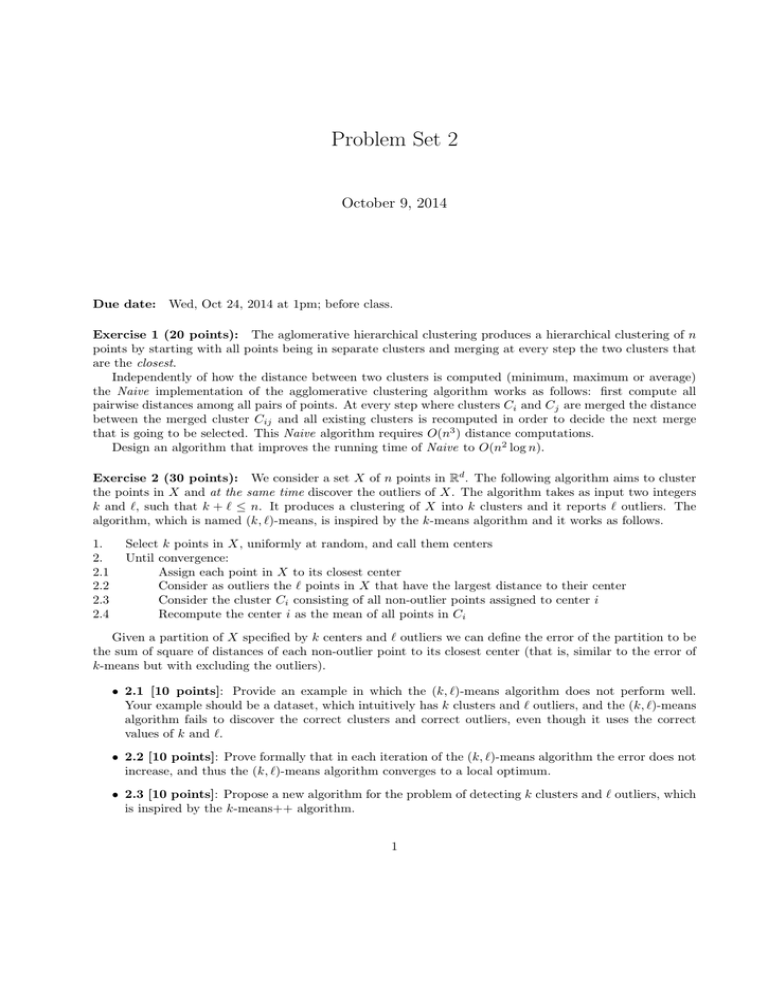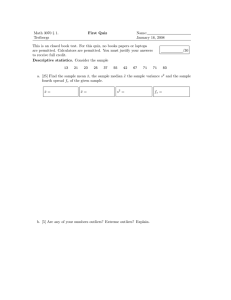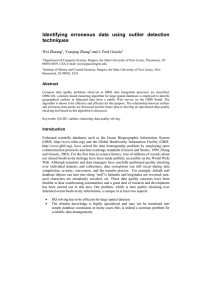Problem Set 2 October 9, 2014
advertisement

Problem Set 2
October 9, 2014
Due date:
Wed, Oct 24, 2014 at 1pm; before class.
Exercise 1 (20 points): The aglomerative hierarchical clustering produces a hierarchical clustering of n
points by starting with all points being in separate clusters and merging at every step the two clusters that
are the closest.
Independently of how the distance between two clusters is computed (minimum, maximum or average)
the Naive implementation of the agglomerative clustering algorithm works as follows: first compute all
pairwise distances among all pairs of points. At every step where clusters Ci and Cj are merged the distance
between the merged cluster Cij and all existing clusters is recomputed in order to decide the next merge
that is going to be selected. This Naive algorithm requires O(n3 ) distance computations.
Design an algorithm that improves the running time of Naive to O(n2 log n).
Exercise 2 (30 points): We consider a set X of n points in Rd . The following algorithm aims to cluster
the points in X and at the same time discover the outliers of X. The algorithm takes as input two integers
k and `, such that k + ` ≤ n. It produces a clustering of X into k clusters and it reports ` outliers. The
algorithm, which is named (k, `)-means, is inspired by the k-means algorithm and it works as follows.
1.
2.
2.1
2.2
2.3
2.4
Select k points in X, uniformly at random, and call them centers
Until convergence:
Assign each point in X to its closest center
Consider as outliers the ` points in X that have the largest distance to their center
Consider the cluster Ci consisting of all non-outlier points assigned to center i
Recompute the center i as the mean of all points in Ci
Given a partition of X specified by k centers and ` outliers we can define the error of the partition to be
the sum of square of distances of each non-outlier point to its closest center (that is, similar to the error of
k-means but with excluding the outliers).
• 2.1 [10 points]: Provide an example in which the (k, `)-means algorithm does not perform well.
Your example should be a dataset, which intuitively has k clusters and ` outliers, and the (k, `)-means
algorithm fails to discover the correct clusters and correct outliers, even though it uses the correct
values of k and `.
• 2.2 [10 points]: Prove formally that in each iteration of the (k, `)-means algorithm the error does not
increase, and thus the (k, `)-means algorithm converges to a local optimum.
• 2.3 [10 points]: Propose a new algorithm for the problem of detecting k clusters and ` outliers, which
is inspired by the k-means++ algorithm.
1
Exercise 3 (25 points): In the k-center problem the input consists of a set of n d-dimensional points
X = {x1 , . . . , xn } and the goal is to partition the points into k groups C1 , . . . , Ck such that:
max max L2 (x − x0 )
i=1...k x,x0 ∈Ci
is minimized. The problem for d ≥ 2 is NP-hard. However, for d = 1 it has a polynomial-time algorithm.
The goal of this excersice is to give an optimal polynomial-time algorithm that solves the k-center problem
for 1-dimensional points in time O(n2 ); your running time should not depend on k. Write the pseudocode
of your algorithm, prove that it is optimal and give a running-time analysis.
Exercise 4 (25 points): Consider the edit distance between two labeled graphs G1 = (V, E1 ) and G2 =
(V, E2 ) with the same set of nodes to be the number of edges in E1 that are not in E2 plus the number of
edges in E2 that are not in E1 . That is,
∆(G1 , G2 ) = |E1 \ E2 | + |E2 \ E1 |.
• 4.1 [10 points]: Prove that ∆() is a metric.
• 4.2 [15 points]: Given a set of graphs G1 , G2 , . . . , Gn consisting of n graphs all sharing the same set
of labeled nodes design an algorithm for finding the centroid of the set of clusters, when distance ∆ is
used as a distance function between graphs.
2




